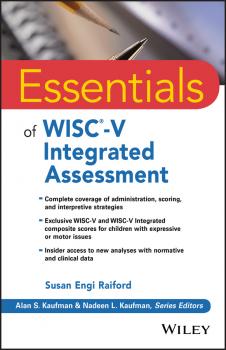ТОП просматриваемых книг сайта:
Susan Raiford Engi
Список книг автора Susan Raiford EngiАннотация
Interpret the WISC–V to help diagnose learning disabilities and to translate profiles of test scores to educational action The Wechsler Intelligence Scale for Children—Fifth Edition (WISC–V) is a valuable tool for assessing children and adolescents with learning disorders—and Intelligent Testing with the WISC–V offers the comprehensive guidance you need to administer, score, and interpret WISC–V profiles for informing diagnoses and making meaningful educational recommendations. This essential resource provides you with cutting-edge expertise on how to interpret the WISC–V, which has an expanded test structure, additional subtests, and an array of new composites. Intelligent Testing offers valuable advice from experienced professionals with regard to clinically applying the WISC–V in an effort to understand a child's strengths and weaknesses—and to create a targeted, appropriate intervention plan. Ultimately, this book equips you with the information you need to identify the best theory-based methods for interpreting each child's profile of test scores within the context of his or her background and behaviors. Intelligent Testing provides a strong theoretical basis for interpreting the WISC–V from several vantage points, such as neuropsychological processing theory and the Cattell-Horn-Carroll (CHC) model, yet it permits you to interpret children's profiles using simple, straightforward steps. The most frequently used IQ test in the world, the WISC–V (like previous versions of the WISC) plays an integral role in evaluating children for learning and intellectual disabilities, developmental and language delays, and gifted and talented classifications. As such, understanding how to use the latest version of WISC is extremely important when assessing children and adolescents ages 6 to 16 years. Explore all aspects of both the conventional WISC–V and WISC–V Digital Read objective, independent test reviews of the WISC–V from independent, highly-respected expert sources Review 17 clinical case reports that spotlight experiences of children and adolescents referred to psychologists for diverse reasons such as reading problems, specific learning disabilities, ADHD, intellectual giftedness, and autistic spectrum disorders Learn how a broad-based, multi-faceted approach to interpretation that calls upon several scientific concepts from the fields of cognitive neuroscience, clinical and school neuropsychology, neuropsychological processing, and the CHC model, can benefit children by providing meaningful recommendations to parents, teachers, and often to the children and adolescents themselves Use the results of WISC–V as a helping agent to assist in creating the best intervention plan, rather than allowing test results to dictate placement or labeling Intelligent Testing with the WISC–V is an indispensable resource for professionals who work with the WISC–V, including school psychologists, clinical psychologists, educational diagnosticians, and more.
Аннотация
Practical, in-depth guidance for WISC-V and WISC-V Integrated assessment Essentials of WISC-V Integrated Assessment is the ideal companion for psychologists and other assessment professionals seeking helpful interpretive and practical information beyond the WISC-V and WISC-V Integrated published manuals. Beginning with an overview of the test and its application to educational intervention, this book provides in-depth information on new administrative, scoring, and interpretation procedures specific to the WISC-V and the WISC-V Integrated. Insider access to the WISC-V and WISC-V Integrated standardization data allows the reader to derive new WISC-V composite scores unavailable from other resources. Readers of this book are the first to receive access to these new composite scores, which are designed to be more appropriate for children with expressive language difficulties and motor impairments. The reader also receives exclusive access to four new WISC-V expanded index scores that provide broader measures of visual spatial ability, working memory, auditory working memory, and processing speed. Significant advances in working memory research demand more comprehensive assessment of children with a broader range of abilities and limitations. The reader will learn how to perform a highly comprehensive assessment of working memory with the WISC-V and the WISC-V Integrated. A digital interpretive tool automatically calculates the new composite scores, completes the relevant comparisons, and generates interpretive information for new comparisons to streamline the reporting process. The WISC-V Integrated serves to expand and clarify WISC-V results by helping practitioners better understand a child's cognitive processes and the reasons for low or discrepant performance. This book helps practitioners get more out of the WISC-V and the WISC-V Integrated, with indispensable guidance and practical tools. Understand the WISC-V Integrated and its proper application to the development of educational interventions Learn how administration, scoring, and interpretation has changed for retained subtests, how to administer and score new subtests, and how to obtain the first-ever composite scores Discover how to use the WISC-V and WISC-V Integrated to assess both auditory and visual working memory, and how to obtain an unparalleled and in-depth picture of working memory along a continuum of cognitive complexity Learn how to adjust WISC-V use for children with expressive or motor difficulties Explore alternative composite scoring based on the WISC-V and WISC-V Integrated standardization data to increase utility for specific populations The WISC-V Integrated is an essential component of the WISC-V assessment process, and Essentials of WISC-V Integrated Assessment is the ideal guide for practitioners.


